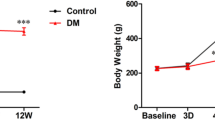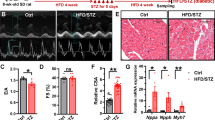Abstract
Patients with chronic diabetes mellitus usually develop reductions in rate and force of cardiac contractions. Since calcium-release channels (ryanodine receptors (RyRs) and inositol 1,4,5-trisphosphate receptors (IP3Rs)) play integral roles in effecting these processes, we rationalize that alterations in their expression may underlie these defects. To test this hypothesis, right atrial appendages were obtained from diabetic (65.0 ± 4.5 years) and nondiabetic (56.2 ± 2.6 years) patients undergoing coronary arterial by-pass grafting and reverse transcription-polymerase chain reactions were used to compare steady state levels of mRNA encoding the three major isoforms of RyRs and IP3Rs. In this study we did not detect either RyR1 or RyR3 in human atrial appendage. When compared with nondiabetic patients, mRNA encoding RyR2 from diabetic patients decreased by 74.2 ± 6.2% (p< 0.01). Diabetes also significantly decreased steady-state levels of mRNA encoding the IP3Rs in human atrial appendage. IP3R1 decreased by 24.2 ± 4.6%, IP3R2 decreased by 63.0 ± 4.6% and IP3R3 decreased by 55.5 ± 6.5%. Since a reduction in steady-state mRNA is usually indicative of a decrease in protein levels, these data suggest that the decrease in chronotropy and inotropy seen in chronic diabetic patients may be due in part to a decrease in expression of calcium-release channels. (Mol Cell Biochem 263: 143–150, 2004)
Similar content being viewed by others
References
Rubler S, Dlugash J, Yuceoglu YZ, Kumral T, Branwood AW, Grishman A: New type of cardiomyopathy associated with diabetic glomerulo-sclerosis. Am J Cardiol 30(6): 595–60, 1972
Asmal AC, Leary WP, Thandroyen FS: Diabetic heart disease. Afr Med J 57(19): 788–790, 1980
Regan TJ: Congestive heart failure in the diabetic. Annu Rev Med 34: 161–168, 1983
Janka HU: Increased cardiovascular morbidity and mortality in diabetes mellitus: Identification of the high risk patient. Diabetes Res Clin Pract 30(suppl): 85–88, 1996
Bell DS: Diabetic cardiomyopathy. A unique entity or a complication of coronary artery disease. Diabetes Care 18(5): 708–714, 1995
Singh N: Diabetes, heart rate, and mortality. J Cardiovasc Pharmacol Ther 7(2): 117–129, 2002
Mahgoub MA, Abd-Elfattah AS: Diabetes mellitus and cardiac function. Mol Cell Biochem 180(1–2): 59–64, 1998
Razeghi P, Young ME, Cockrill TC, Frazier OH, Taegtmeyer H: Down-regulation of myocardial myocyte enhancer factor 2C and myocyte en-hancer factor 2C-regulated gene expression in diabetic patients with nonischemic heart failure. Circulation 106(4): 407–411, 2002
Trost SU, Belke DD, Bluhm WF, Meyer M, Swanson E, Dillmann WH: Overexpression of the sarcoplasmic reticulum Ca(2+)-ATPase improves myocardial contractility in diabetic cardiomyopathy. Diabetes 51(4): 1166–1171, 2002
Golfman L, Dixon IM, Takeda N, Chapman D, Dhalla NS: Differential changes in cardiac myofibrillar and sarcoplasmic reticular gene expres-sion in alloxan induced diabetes. Mol Cell Biochem 200(12): 15–25, 1999
Teshima Y, Takahashi N, Saikawa T, Hara M, Yasunaga S, S, Sakata T: Diminished expression of sarcoplasmic reticulum Ca(2+)-ATPase and ryanodine sensitive Ca(2+) channel mRNA in.150 streptozotocin-induced diabetic rat heart. J Mol Cell Cardiol 32(4): 655–664, 2000
Netticadan T, Temsah RM, Kent A, Elimban V, Dhalla NS: Depressed levels of Ca2+-cycling proteins may underlie sarcoplasmic reticulum dysfunction in the diabetic heart. Diabetes 50(9): 2133–2138, 2001
Zhong Y, Ahmed S, Grupp IL, Matlib MA: Altered SR protein expres-sion associated with contractile dysfunction in diabetic rat hearts. Am J Physiol 281(3): H1137–H1147, 2001
Bidasee KR, Dincer UD, Besch HR Jr: Ryanodine receptor dysfunction in hearts of streptozotocin-induced diabetic rats. Mol Pharmacol 60(6): 1356–1364, 2001
Dinçer UD, Bidasee KR, Tay A, Güner S, Özçelikay TA, Altan VM: The mRNAexpression of IP3receptors in diabetic rat hearts. In: International Conference on Diabetes and Cardiovascular disease, Winnepeg, Canada, June 1999
Fill M, Copello JA: Ryanodine receptor calcium release channels. Phys-iol Rev 82(4): 893–922, 2002
Marks AR: Intracellular calcium-release channels–regulators of cell life and death. Am J Physiol 272(2 pt 2): H597–H605, 1997
Nadif Kasri N, Bultynck G, Sienaert I, Callewaert G, Erneux C, Missiaen L, Parys JB, De Smedt H: The role of calmodulin for inositol 1,4,5-trisphosphate receptor function. Biochim Biophys Acta 1600(1–2): 19–31, 2002
Patel S, Joseph SK, Thomas AP: Molecular properties of inositol 1,4,5-trisphosphate receptors. Cell Calcium 25(3): 247–264, 1999
Bers DM: Cardiac–excitation–contraction coupling. Nature 415(6868): 198–205, 2002
Franzini-Armstrong C, Protasi F: Ryanodine receptors of striated mus-cles: a complex channel capable of multiple interactions. Physiol Rev 77(3): 699–729, 1997
Bohle T, Brandt MC, Henn N, Schmidt A, Bloch W, Beuckelmann DJ: Identification of the cardiac ryanodine receptor channel in mem-brane blebs of sarcoplasmic reticulum. FEBS Lett 505(3): 419–425, 2001
Munch G, Bolck B, Sugaru A, Schwinger RH: Isoform expression of the sarcoplasmic reticulum Ca2+ release channel (ryanodine channel) in human myocardium. J Mol Med 78(6): 352–360, 2000
Huisamen B, Mouton R, Opie LH, Lochner A: Effects of ischaemia, reperfusion and alpha 1-adrenergic receptor stimulation on the inositol trisphosphate receptor population in rat heart atria and ventricles. Mol Cell Biochem 140(1): 23–30, 1994
Endoh M, Fujita S, Yang HT, Talukder MA, Maruya J, Norota I: En-dothelin: receptor subtypes, signal transduction, regulation of Ca 2+ transients and contractility in rabbit ventricular myocardium. Life Sci. 62(17–18): 1485–1489, 1998
Novakova M, Ela C, Bowen WD, Hasin Y, Eilam Y: Highly selective sigma receptor ligands elevate inositol 1,4,5-trisphosphate pro-duction in rat cardiac myocytes. Eur J Pharmacol 353(2–3): 315–327, 1998
Viko H, Sandnes D, Skomedal T, Osnes JB: Effect of concomitant beta-adrenoceptor stimulation on alpha 1-adrenoceptor-mediated increase of inositol-1,4,5-trisphosphate mass in adult rat cardiomyocytes. Pharma-col Toxicol 83(1): 23–28, 1998
Kijima Y, Saito A, Jetton TL, Magnuson MA, Fleischer S: Different intracellular localization of inositol 1,4,5-trisphosphate and ryanodine receptors in cardiomyocytes. J Biol Chem 268(5): 3499–3506, 1993
Gorza L, Schiaffino S, Volpe P: Inositol 1,4,5-trisphosphate receptors in the heart: Evidence for its concentration in Purkinje myocytes of the conduction system. J Cell Biol 121: 345–353, 1993
Perez PJ, Ramos-Franco J, Fill M, Mignery GA: Identification and func-tional reconstitution of the type 2 inositol 1,4,5-trisphosphate receptor from ventricular cardiac myocytes. J Biol Chem 272(38): 23961–23969, 1997
Haak LL, Song LS, Molinski TF, Pessah IN, Cheng H, Russell JT: Sparks and puffs in oligodendrocyte progenitors: Cross talk between ryanodine receptors and inositol trisphosphate receptors. J Neurosci 21(11): 3860–3870, 2001
Dinçer UD, Bidasee KR, Güner S, Tay A, Ozcelikay AT, Altan VM: The effects of diabetes on expression of β1-, β2-and β3-adrenoceptors in rat hearts. Diabetes 50: 455–461, 2001
Hancox JC, Levi AJ, Brooksby P: Intracellular calcium transients recorded with Fura-2 in spontaneously active myocytes isolated from the atrioventricular node of the rabbit heart. Proc R Soc Lond B Biol Sci 255(1343): 99–105, 1994
Vinogradova TM, Bogdanov KY, Lakatta EG: beta-Adrenergic stimu-lation modulates ryanodine receptor Ca(2+) release during diastolic de-polarization to accelerate pacemaker activity in rabbit sinoatrial nodal cells. Circ Res 90(1): 73–99, 2002
Brillantes AM, Allen P, Takahashi T, Izumo S, Marks AR: Differences in cardiac calcium release channel (ryanodine receptor) expression in versus dilated cardiomyopathy. Circ Res 71(1): 18–26, 1992
Go LO, Morschella MC, Watras J, Handa KK, Fyfe BS, Marks AR: Differential regulation of two types of intracellular calcium release channels during end-stage heart failure. J Clin Invest 95(2): 888–894, 1995
Ju H, Scammel-La Fleur T, Dixon IM: Altered mRNA abundance of calcium transport genes in cardiac myocytes induced by angiotensin II. J Mol Cell Cardiol 28(5): 1119–1128, 1996
Ueyama T, Ohkusa T, Hisamatsu Y, Nakamura Y, Yamamoto T, Yano M, Matsuzaki M. Alterations in cardiac SR Ca(2+)-release channels during development of heart failure in cardiomyopathic hamsters. Am J Physiol 274(1 pt 2): H1–H7, 1998
Abu-Lebdeh HS, Nair KS: Protein metabolism in diabetes mellitus. Baillieres Clin Endocrinol Metab 10(4): 589–601, 1996
Tessari P: Changes in protein, carbohydrate, and fat metabolism with aging: Possible role of insulin. Nutr Rev 58(1): 11–19, 2000
Dincer UD, Onay A, Ari N, Ozcelikay AT, Altan VM: The effects of diabetes on beta-adrenoceptor mediated responsiveness of human and rat atria. Diabetes Res Clin Pract 40(2): 113–122, 1998
Author information
Authors and Affiliations
Rights and permissions
About this article
Cite this article
Guner, S., Arioglu, E., Tay, A. et al. Diabetes decreases mRNA levels of calcium-release channels in human atrial appendage. Mol Cell Biochem 263, 143–150 (2004). https://doi.org/10.1023/B:MCBI.0000041856.92497.0c
Issue Date:
DOI: https://doi.org/10.1023/B:MCBI.0000041856.92497.0c




